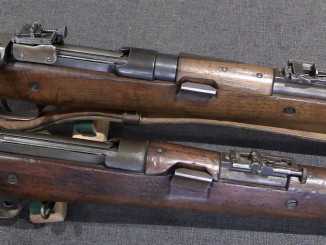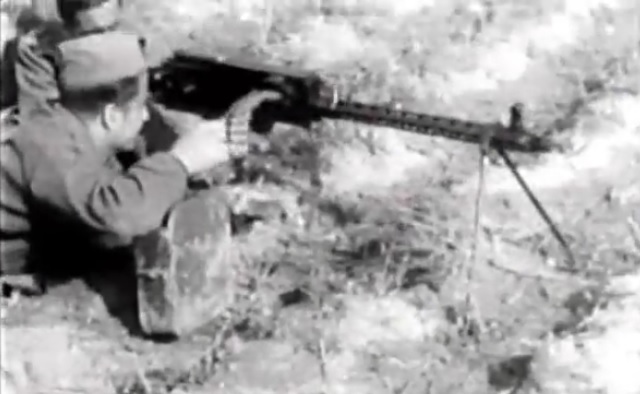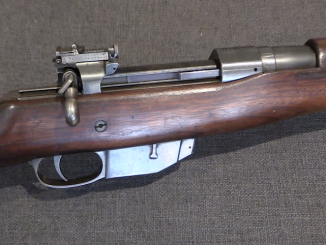The Canadian infantry that went to Europe in the early years of World Wa rOne were equipped primarily with the Ross MkIII rifle. The Ross would become quite the scandal, and was replaced in service with the SMLE in 1916 – but as a sniper rifle the Ross excelled. Its problems in service were largely based on poor quality ammunition, and this was not an issue for the sniper corps. In addition, Great Britain was having enough trouble equipping its own snipers to have any extra scoped rifles to hand over to the dominions.
And so, the Canadians modified 500 Ross rifles into a sniper configuration using American-sourced Warner & Swasey M1913 “Musket Sight” scopes. These were 5x magnification prismatic scopes, also used by American forces on the M1903 sniper rifle and the M1909 Benet-Mercie machine guns. The scope was not very good, suffering from fogging and other issues, but it was available. The Canadian rifles were made in two batches of 250 each, one in 1915 and one in 1917. This was actually more rifles than needed, and many of them (including the two in this video) remained in Canada for training (and were used at least until 1942).
Canadian Warner & Swasey scopes can be identified by three elements. They have elevation dials marked out to 2400 yards, serial numbers between 1 and 500, and no data plate on top. Canadian scope cases are marked with the serial numbers of the scope and the rifle they were issued with.




Stupid question: assuming a better scope was mated to the rifle and good ammunition was provided, along with a well-fitted reciprocating receiver cover (for keeping mud out of the bolt track), would this particular system work out well, or would a potential user just toss it for something else out of sheer spite?
As Ian mentioned, snipers didn’t have much trouble with the Ross. Many of the problems the Ross had were related to it being designed for pre-war, high quality Canadian ammo. It had a very tight chamber, and didn’t like wartime relaxed standards British ammo. The other issue it had was that many of its problems manifested with heating from rapid fire.
If you were a sniper, you coddled your rifle, used carefully hoarded ammo from lots that were known to be consistent, and only fired a few shots from prepared positions, so the weaknesses of the Ross were reduced, and the strengths magnified. Its problems really boiled down to it being a rifle optimized for NRA style long range target shooting, and while that didn’t really work as a simulacrum for infantry combat, it certainly did for sniping. The very things that made the Ross a lousy infantry rifle made it a superb sniper rifle and it was highly regarded as such.
I have a book on Canadian sniping, and has illustrations of several Ross snipers. Interestingly, several have the stocks cut off to free float them, much like how the British post WWII conversions of the No.4 had cut-off stocks.
In A Rifleman Went to War, McBride talks about the Ross as a sniper rifle, and how having identified a particularly good batch of ammo, all cases of ammo with that lot number were grabbed for the snipers. He also talks about putting slivers of razor blade in the mounts as shims, and deliberately letting them rust in place to increase the rigidity of the mounts/scope interface.
I have only ever seen one sniper Ross before this video, and that is the one displayed at the Canadian War Museum in Ottawa, which is displayed alongside a hand made and painted sniper’s cloak and mask.
“He also talks about putting slivers of razor blade in the mounts as shims, and deliberately letting them rust in place to increase the rigidity of the mounts/scope interface.”(C)
Interesting.
Did he mention only this?
I met somewhere that the attachment of the sighting bracket itself could also weaken and needed regular checking.
And also, I met the mention of the unexpected side of too thin tolerance. And not only on the quality of the cartridges.
With intensive shooting, the bolt was heated and began to wedge in the box. They learned how to fix it by grinding blocking protrusions. Or (oh, horror) completely cutting or breaking off the back of them.
The top sniper rifle as used by the top sniper of WWI:
https://en.wikipedia.org/wiki/Francis_Pegahmagabow
https://www.youtube.com/watch?v=kYzDBeG3By0
The Canadian Department of Militia & Defence requested permission to buy 832 W&S scopes in December 1914. The government refused and passed it back to the Minister, Sam Hughes. Finally they agreed on 250 to start, with more if satisfactory. Delivery from W&S was “haphazard, so the first 40 were only sent to France on Sept. 28, 1915. So there you have it: long before the War Office had even been asked by people like Hesketh Prichard and before Canadian troops even landed in France. The source for this is documents in the Canadian national archives studied by Clive Law for his book “Without Warning”.